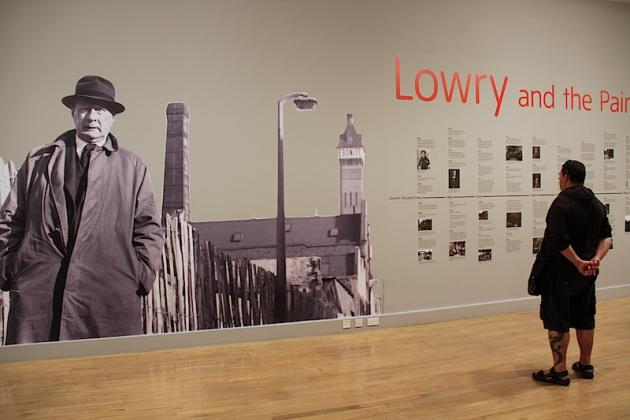Natural figures would have broken the spell of my visions so I made them unreal – L.S. Lowry
The decision to showcase the career of LS Lowry is bold as well as timely because of the enormity of the debate surrounding his work. Curators TJ Clark and Anne Wagner have set off with the intention to bring it to the public, stating that they wanted this show to be “for believers, but also for cynics”, and that they wanted to open the eyes of those who thought he was an anomaly in British painting. I believe their objective is a noble one, for Lowry is an enigmatic figure who certainly seems to be misunderstood, and this exhibition is utterly thought-provoking, not because it is about championing the working class in post-industrial Britain, nor because he might have, as some have suggested, found beauty in the proletariat. In fact, I don’t believe there was a dramatic intention or aspiration towards realism in people. Instead, Lowry was quite conceptual in his approach, and he knew what he was doing as a painter, and his mode of execution was deliberate and considered. It is then left to us to ask questions.
In my opinion Lowry was a painter of landscape and of atmosphere, he was also a painter of symbols and icons of which members of the working class were representatives, and post-industrial Britain was his vista. The paradox about his work is that people are very important in his paintings, yet they are faceless or nondescript, showing no trace of individuality or character whatsoever. But what is important is that they operate as a group, not as individuals, and in this sense they become elements of a landscape. He said: “I only deal with poverty, always with gloom”, but it was about a subject rather than a cause. “I wanted to paint myself into what absorbed me […] Natural figures would have broken the spell of it, so I made my figures half unreal. Some critics have said that I turned my figures into puppets, as if my aim were to hint at the hard economic necessities that drove them. To say the truth, I was not thinking very much about the people. I did not care for them in the way a social reformer does. They are part of a private beauty that haunted me. I loved them and the houses in the same way: as part of a vision”.

This is what makes Lowry compelling. In essence what he has done is to reinvent a notion of landscape painting. He is also incredibly daring because it isn’t particularly evident that he knew what he was doing, because he worked in a rather naïve, childlike manner with matchstick people and a seemingly disingenuous (or so he has been accused) treatment of the picture surface. However, his method had its foundation in skillful and deliberate formal methodology, and this is one of the strengths of this exhibition: that it reveals Lowry’s education and association with late nineteenth century painting. It also unveils his skill.
His tutor was Pierre Adolphe Valette, a French impressionist painter who showed Lowry the potential of urban landscape as a subject. Lowry was also regularly accepted in Parisian salons. This stature is presented in the second room of the exhibition where works by Van Gogh, Valette, Seurat, and Pissaro are shown in comparison and contrast to Lowry’s. The influence of colour palette, and formal considerations are apparent, but Lowry diverged in style and subject to the impressionist masters who respected him as a peer.
A selection of his drawings also form part of the exhibition and are an invaluable inclusion. These clearly demonstrate his formal training and dexterous use of a pencil, dispelling accusations that he was merely a Sunday painter who didn’t really know what he was doing. They are highly skilled, beautifully rendered and betray a virtuoso use of line as well as composition. They also show the bones for the creation of his painted works, which if you look closely, show how his mark-making for example, is a rehearsal for the brushwork of the paintings to depict mood, like the sensitive manner in which he pushes the paint around to render the snowy haze in the skies, or the general atmosphere of post-industrial air replete with pollution and gloom.
Lowry’s place in the annals of British painting can be said to be an anomaly. Whether you like his work or not is unnecessary because what is compelling is the fact that he uses all the formal vocabulary available to him in what is known as good picture making under a very subtle and clever disguise. He uses colour selectively in order to navigate the eye as well as to create depth. He creates symbols of people like musical notation to form atmospheres of patterns, and what seem like naïve paintings are actually incredible formal constructions and compositions. These elements yield a compelling mélange of what is pictorially vivid and pictorially unfamiliar. For this reason, Lowry deserves a second look, and this exhibition is an important one that should be seen.
WORDS: KAREN GARRATT PHOTOS: P C ROBINSON @ ARTLYST 2013
Lowry and the Painting of Modern Life Tate Britain Until20 October 2013

